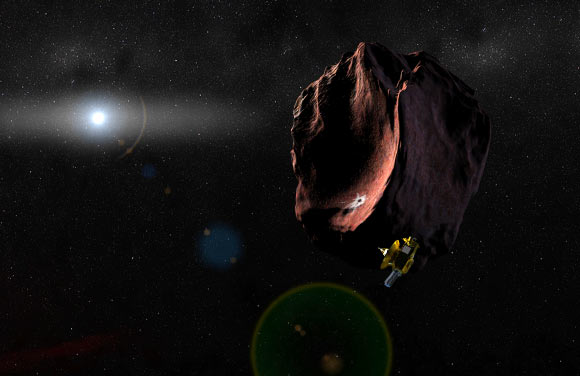NASA’s New Horizons spacecraft has made its first detection of its next target, the Kuiper Belt object 2014 MU69, more than four months ahead of its 2019 close encounter.
MU69 is a relatively small Kuiper Belt object. It is estimated to have a diameter of 30 miles (48 km) — that’s more than 10 times larger and 1,000 times more massive than typical comets, but only about 0.5 to 1% of the size of the dwarf planet Pluto.
This object was discovered in June 2014 by astronomers using the NASA/ESA Hubble Space Telescope.
Also known as PT1 and 1110113Y, and nicknamed Ultima Thule, MU69 orbits the Sun once every 293 years at a distance of more than 4 billion miles (6.5 billion km) from Earth.
The MU69 flyby will be the first-ever close-up exploration of a small Kuiper Belt object and the farthest exploration of any planetary body in history, shattering the record New Horizons itself set at Pluto in July 2015 by about one billion miles (1.6 billion km).

The figure on the left is a composite image produced by adding 48 different exposures from News Horizons’ Long Range Reconnaissance Imager, each with an exposure time of 29.967 seconds, taken on August 16, 2018. The predicted position of 2014 MU69 is at the center of the yellow box, and is indicated by the yellow crosshairs, just above and left of a nearby star that is approximately 17 times brighter than 2014 MU69. At right is a magnified view of the region in the yellow box, after subtraction of a background star field ‘template’ taken by LORRI in September 2017 before it could detect the object itself. 2014 MU69 is clearly detected in this star-subtracted image and is very close to where scientists predicted, indicating to the team that New Horizons is being targeted in the right direction. The many artifacts in the star-subtracted image are caused either by small mis-registrations between the new LORRI images and the template, or by intrinsic brightness variations of the stars. At the time of these observations, 2014 MU69 was 107 million miles (172 million km) from the New Horizons spacecraft and 4 billion miles (6.5 billion km) from the Sun. Image credit: NASA / JHUAPL / SwRI.
New Horizons mission scientists were thrilled that the spacecraft’s Long Range Reconnaissance Imager (LORRI) was able to see the small, dim object while still more than 100 million miles (161 million km) away, and against a dense background of stars.
Taken August 16 and transmitted home through NASA’s Deep Space Network over the following days, the set of 48 images marked the team’s first attempt to find MU69 with New Horizons’ own cameras.
“The image field is extremely rich with background stars, which makes it difficult to detect faint objects,” said New Horizons project scientist and LORRI principal investigator Dr. Hal Weaver, a researcher at the Johns Hopkins Applied Physics Laboratory.
“It really is like finding a needle in a haystack. In these first images, Ultima appears only as a bump on the side of a background star that’s roughly 17 times brighter, but Ultima will be getting brighter — and easier to see — as the spacecraft gets closer.”
“Our team worked hard to determine if Ultima was detected by LORRI at such a great distance, and the result is a clear yes,” said New Horizons principal investigator Dr. Alan Stern, from the Southwest Research Institute.
“We now have Ultima in our sights from much farther out than once thought possible. We are on Ultima’s doorstep, and an amazing exploration awaits.”
Source: Sci News

































Leave a Comment
You must be logged in to post a comment.